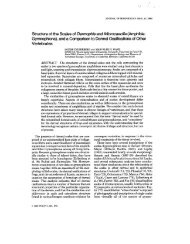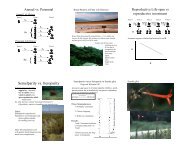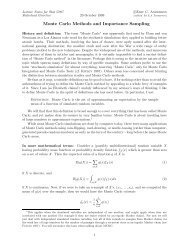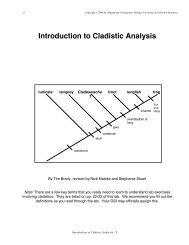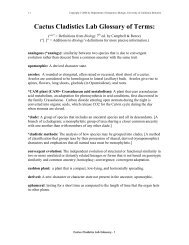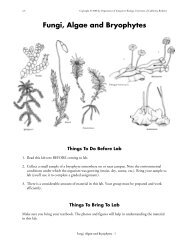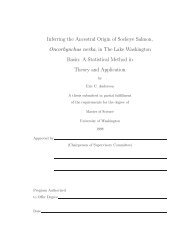Using ecological niche modeling for quantitative biogeographic ...
Using ecological niche modeling for quantitative biogeographic ...
Using ecological niche modeling for quantitative biogeographic ...
You also want an ePaper? Increase the reach of your titles
YUMPU automatically turns print PDFs into web optimized ePapers that Google loves.
610 KAITLIN C. MAGUIRE AND ALYCIA L. STIGALL<br />
from bioin<strong>for</strong>matics attack a pressing problem. BioScience<br />
51:363–371.<br />
Peterson, A. T., J. Soberón, V. Sánchez-Cordero. 1999. Conservatism<br />
of <strong>ecological</strong> <strong>niche</strong>s in evolutionary time. Science<br />
285:1265–1267.<br />
Peterson, A. T., V. Sánchez-Cordero, J. Soberón, J. Bartley, R. W.<br />
Buddemeier, and A. G. Navarro-Sigüenza. 2001. Effects of<br />
global climate change on geographic distributions of Mexican<br />
Cracidae. Ecological Modelling 144:21–30.<br />
Peterson, A. T., L. G. Ball, and K. P. Cohoon. 2002. Predicting<br />
distributions of Mexican birds using <strong>ecological</strong> <strong>niche</strong> <strong>modeling</strong><br />
methods. Ibis 144:E27–E32.<br />
Prado, J. L., and M. T. Alberdi. 1996. A cladistic analysis of the<br />
horses of the tribe Equini. Palaeontology 39:663–680.<br />
Raxworthy, C. J., E. Martinez-Meyer, N. Horning, R. A.<br />
Nussbaum, G. E. Schneider, M. A. Ortega-Huerta, A. T.<br />
Peterson. 2003. Predicting distributions of known and unknown<br />
reptile species in Madagascar. Nature 426:837–841.<br />
Retallack, G. J. 1994. The environmental factor approach to the<br />
interpretation of paleosols. In R. J. Luxmore, ed. Factors of soil<br />
<strong>for</strong>mation: a fiftieth anniversary retrospective. SSA Special<br />
Publication 33:31–64. Social Science Society of America,<br />
Madison, Wisc.<br />
———. 1997. Neogene expansion of the North American Prairie.<br />
Palaios 12:380–390.<br />
———. 2005. Pedogenic carbonate proxies <strong>for</strong> amount and<br />
seasonality of precipitation in paleosols. Geology 33:333–336.<br />
———. 2007. Cenozoic paleoclimate on land in North America.<br />
Journal of Geology 115:271–294.<br />
Rocchi, S., G. Di Vincenzo, and W. E. LeMasurier. 2006. Oligocene<br />
to Holocene erosion and glacial history in Marie Byrd Land,<br />
West Antarctica, inferred from exhumation of the Dorrel Rock<br />
intrusive complex and from volcano morphologies. Geological<br />
Society of America Bulletin 118:991–1005.<br />
Rode, A. L., and B. S. Lieberman. 2004. <strong>Using</strong> GIS to unlock the<br />
interactions between biogeography, environment, and evolution<br />
in Middle and Late Devonian brachiopods and bivalves.<br />
Palaeogeography, Palaeoclimatology, Palaeoecology 211:345–<br />
359.<br />
Scott, G. R. 1982. Paleovalley and geologic map of northeastern<br />
Colorado. U.S. Geological Survey Miscellaneous Investigation<br />
Series Map I-378.<br />
Shotwell, J. A. 1961. Late Tertiary biogeography of horses in the<br />
Northern Great Basin. Journal of Paleontology 35:203–217.<br />
Simpson, G. G. 1953. The major features of evolution. Columbia<br />
University Press, New York.<br />
Skinner, M. F., and B. J. MacFadden. 1977. Cormohipparion n. gen.<br />
(Mammalia, Equidae) from the North American Miocene<br />
(Barstovian–Clarendonian). Journal of Paleontology 51:912–926.<br />
Stanley, S. M. 1974. Effects of competition on rates of evolution,<br />
with special reference to bivalve mollusks and mammals.<br />
Systematic Zoology 22:486–506.<br />
———. 1979. Macroevolution, pattern and process. W. H.<br />
Freeman, San Francisco, Calif.<br />
Steven, T. A., E. Evanoff, and R. H. Yuhas, 1997. Middle and Late<br />
Cenozoic tectonic and geomorphic development of the Front<br />
Range of Colorado. Pp. 115–124 in E. W. Bolyard and S. A.<br />
Sonnenberg, eds. Geologic history of the Colorado Front Range.<br />
RMS-AAPG Field Trip No. 7. Rocky Mountain Association of<br />
Geologists, Denver, Colo.<br />
Stigall, A. L. 2008. Tracking species in space and time: assessing<br />
the relationships between paleobiogeography, paleoecology,<br />
and macroevolution. In P. H. Kelly and R. K. Bambach, eds.<br />
From evolution to geobiology: research questions driving<br />
paleontology at the start of a new century. Paleontological<br />
Society Papers 14:227–242.<br />
———. 2009. Integrating GIS and phylogenetic biogeography to<br />
assess species-level <strong>biogeographic</strong> patterns: a case study of Late<br />
Devonian faunal dynamics. In P. Upchurch, A. McGowan, and<br />
C. Slater eds. Palaeogeography and palaeobiogeography:<br />
biodiversity in space and time. CRC Press, Boca Raton, Fla.<br />
(in press).<br />
Stigall, A. L., and B. S. Lieberman. 2006. Quantitative paleobiogeography:<br />
GIS, phylogenetic <strong>biogeographic</strong> analysis, and<br />
conservation insights. Journal of Biogeography 33: 2051–2060.<br />
Stigall Rode, A. L. 2005. The application of geographic in<strong>for</strong>mation<br />
systems to paleobiogeography: implications <strong>for</strong> the study<br />
of invasions and mass extinctions. In B. S. Lieberman and A. L.<br />
Stigall Rode, eds. Paleobiogeography: generating new insights<br />
into the coevolution of the earth and its biota. Paleontological<br />
Society Papers 11:77–88.<br />
Stigall Rode, A. L., and B. S. Lieberman. 2005. <strong>Using</strong> environmental<br />
<strong>niche</strong> <strong>modeling</strong> to study the Late Devonian biodiversity<br />
crisis. Pp. 93–127 in D. J. Over, J. R. Morrow, and P. B. Wignall,<br />
eds. Understanding Late Devonian and Permian-Triassic biotic<br />
and climatic events: towards an integrated approach (Developments<br />
in Paleontology and Stratigraphy, Vol. 20). Elsevier,<br />
Amsterdam.<br />
Stockwell, D. R. B., and I. R. Noble. 1992. Induction of sets of rules<br />
from animal distribution data: a robust and in<strong>for</strong>mative<br />
method of data analysis. Mathematical and COMPUTER<br />
Simulation 33:385–390.<br />
Stockwell, D. R. B., and D. Peters. 1999. The GARP <strong>modeling</strong><br />
system: problems and solutions to automated spatial prediction.<br />
International Journal of Geographical In<strong>for</strong>mation Science<br />
13:143–158.<br />
Stockwell, D. R. B., and A. T. Peterson. 2002. Effects of sample size<br />
on accuracy of species distribution models. Ecological Modelling<br />
148:1–13.<br />
Strömberg, C. A. 2004. <strong>Using</strong> phytolith assemblages to reconstruct<br />
the origin and spread of grass-dominated habitats in the Great<br />
Plains of North America during the late Eocene to early<br />
Miocene. Palaeogeography, Palaeoclimatology, Palaeoecology<br />
207:239–275.<br />
Swinehart, J. B., and R. F. Diffendal. 1989. Geology of the predune<br />
strata. Pp. 29–42 in A. S. Bleed and C. A. Flowerday, eds.<br />
An atlas of the Sand Hills (Resource Atlas 5b). Conservation<br />
and Survey Division, Institute of Agriculture and Natural<br />
Resources, University of Nebraska-Lincoln.<br />
Thomasson, J. R. 1980. Archaeoleersia nebraskensis gen. et sp. nov.<br />
(Gramineae-Oryzeae), a new fossil grass from the late Tertiary<br />
of Nebraska. American Journal of Botany 67:876–882.<br />
———. 1983. Carex graceii sp. n., Cyperocarpus eliasii sp. n.,<br />
Cyperocarpus terrestris sp. n., and Cyperocarpus pulcherrima sp. n.<br />
(Cyperaceae) from the Miocene of Nebraska. American Journal<br />
of Botany 70:435–449.<br />
———. 1990. Fossil plants from the late Miocene Ogallala<br />
Formation of central North America: possible paleoenvironmental<br />
and biostratigraphic significance. Pp. 99–114 in T. C.<br />
Gustavson, ed. Geologic framework and regional hydrology:<br />
Upper Cenozoic Blackwater Draw Ogallala Formations, Great<br />
Plains. Bureau of Economic Geology, University of Texas,<br />
Austin.<br />
———. 1991. Sediment-borne ‘‘seeds’’ from Sand Creek, northwestern<br />
Kansas: taphonomic significance and paleo<strong>ecological</strong><br />
and paleoenvironmental implications. Palaeogeography, Palaeoclimatology,<br />
Palaeoecology 85:213–225.<br />
———. 2005. Berriochloa gabeli and Berriochloa huletti (Gramineae:<br />
Stipeae), two new grass species from the late Miocene Ash<br />
Hollow Formation of Nebraska and Kansas. Journal of<br />
Paleontology 79:185–199.<br />
Tieszen, L. L., and T. W. Boutton. 1989. Stable carbon isotopes in<br />
terrestrial ecosystems research. Pp. 167–195 in P. W. Rundel,<br />
J. R. Ehleringer, and N. A. Nagy, eds. Stable isotopes in<br />
<strong>ecological</strong> research. Springer, New York.



